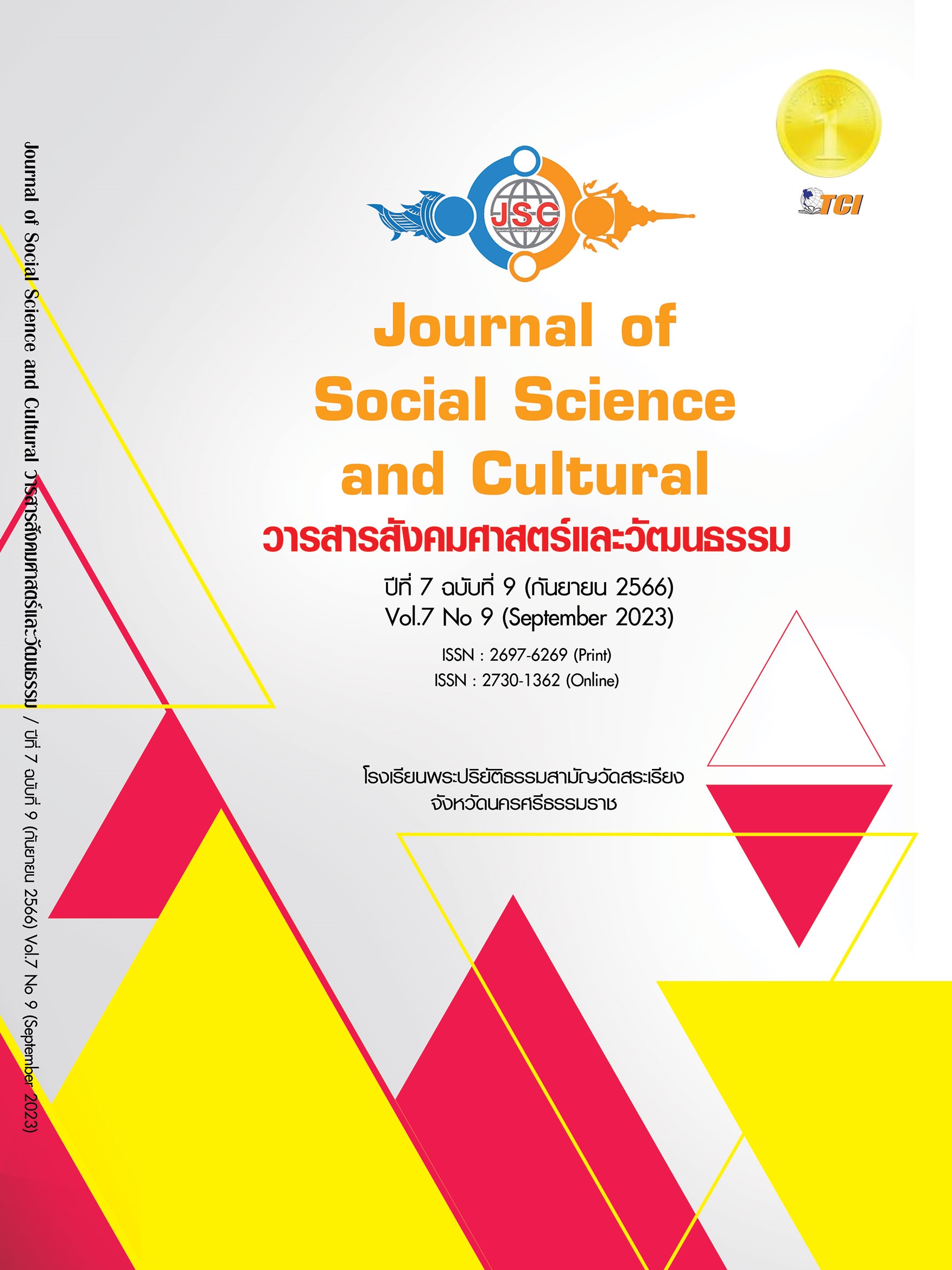THE PROCESS OF USING THE MODEL TO PROMOTE A MULTICULTURAL SOCIETY WITH COMMUNITY PARTICIPATION NATHAB MODEL TO RAISE AWARENESS OF CITIZENSHIP OF SOCIETY IN NATHAB SUBDISTRICT CHANA, DISTRICT, SONGKHLA PROVINCE
Main Article Content
Abstract
This research aims to study the process of bring a pattern strengthening a multicultural society with community participation (Nathab Model). Go and try it out with a model community and evaluation used of model the Nathab Model. The sample used in this research is people in the area Nathab Subdistrict, Chana District, Songkhla Province. Classified into 2 groups is the sample group for collecting qualitative data of 60 persons and quantitative data of 392 persons. The tools used in this research were in-depth interviews and evaluation questionnaires. Statistics used were percentage, mean and standard deviation. The findings of the study reveal that. The process of applying the Nathab Model to community has 6 steps: 1) Organize a meeting of partners in cooperation networks. 2) Consider drafting an annual event calendar and good stuff Nathab. 3) Determine an action plan for pilot activities Nathab Subdistrict. 4) Set up an annual activity calendar and good stuff Nathab. 5) Organize a pilot project is "Annual event in Nathab Subdistrict (Khong de 4 Chay)”. 6) Evaluate and summarize the results of the pilot project. As for the evaluation used of the Nathab Model, it was found that people of Nathab Subdistrict there are opinions on the Nathab Model for promoting a multicultural society with community participation (Nathap Model) on the issue of the model development process and operations using the Nathab Model Overall at a highest level that with an average of 4.02. Considering each issue: was obtained from the project matched expectations with the highest mean equal to 4.20 Followed by the issue Spatial data is used to Develop a suitable format The mean was 4.12 Participation issues in proposing ideas and guidelines for the development of the Nathab Model is consistent with the way of life of the people in Nathap Subdistrict with an average of 4.04, respectively.
Article Details
References
เทศบาลตำบลนาทับ. (2566). แผนพัฒนาท้องถิ่น พ.ศ. 2566 - 2570. สงขลา: เทศบาลตำบลนาทับ.
ขันทอง วัฒนะประดิษฐ์ และคณะ. (2564). รูปแบบการสร้างสังคมพหุวัฒนธรรมโดยไร้รอยต่อทางศาสนา. วารสารมหาจุฬานาครทรรศน์, 8(3), 436-450.
ถวิลวดี บุรีกุล และคณะ. (2556). โครงการเสริมสร้างความเข้มแข็งให้กับองค์กรปกครองส่วนท้องถิ่น ในภาคใต้ของประเทศไทยโดยใช้กระบวนการมีส่วนร่วม. ใน รายงานการวิจัย. สถาบันพระปกเกล้า.
บุญชม ศรีสะอาด. (2556). การวิจัยเบื้องต้น. (พิมพ์ครั้งที่ 9). กรุงเทพมหานคร: สุวีริยาสาส์น.
พระมหาประกาศิต ฐิติปสิทธิกร และคณะ. (2563). จิตสำนึกความเป็นพลเมืองดีในการพัฒนาชุมชนและความเป็นเมืองเชิงพุทธในจังหวัดนครปฐม. วารสารสหวิทยาการมนุษยศาสตร์และสังคมศาสตร์, 3(1), 63-80.
พิชิต ฤทธิ์จรูญ. (2544). หลักการวัดผลและประเมินผลการศึกษา. กรุงเทพมหานคร: สถาบันราชภัฏพระนคร.
ศูนย์ประสานการปฏิบัติที่ 5 กองอำนวยการรักษาความมั่นคงภายในราชอาณาจักร. (2563). ยุทธศาสตร์การพัฒนาจังหวัดชายแดนภาคใต้ พ.ศ. 2563 - 2565. เรียกใช้เมื่อ 19 มิถุนายน 2566 จาก https://www. isoc5.net/files/strategy_plan/2063.pdf
สวรินทร์ เบ็ญเด็มอะหลี. (2554). พลวัตสิทธิชุมชนคลองนาทับ ตำบลนาทับ อำเภอจะนะ จังหวัดสงขลา. ใน วิทยานิพนธ์ศิลปศาสตร์มหาบัณฑิต สาขาวิชาพัฒนามนุษย์และสังคม. มหาวิทยาลัยสงขลานครินทร์.
สำเร็จ ศรีหร่าย. (2550). ขบวนการ BRN-Coordinate กับการก่อความไม่สงบในพื้นที่ 3 จังหวัดชายแดนภาคใต้และ 4 อำเภอของจังหวัดสงขลาในช่วงปี พ.ศ. 2547-ปัจจุบัน (2550) และแนวความคิดในการยุติสถานการณ์. ใน รายงานการวิจัย. วิทยาลัยป้องกันราชอาณาจักร.
Cohen, J. M. & Ophoff, N.N.T. (1981). Rural Development Participation: Concepts and Measures for Project Design, Implementation and Evaluation. New York: The Rural Development Committee Center for International Studies, Cornell University.
Faulks, K. (2000). Citizenship. London: Century Business.


